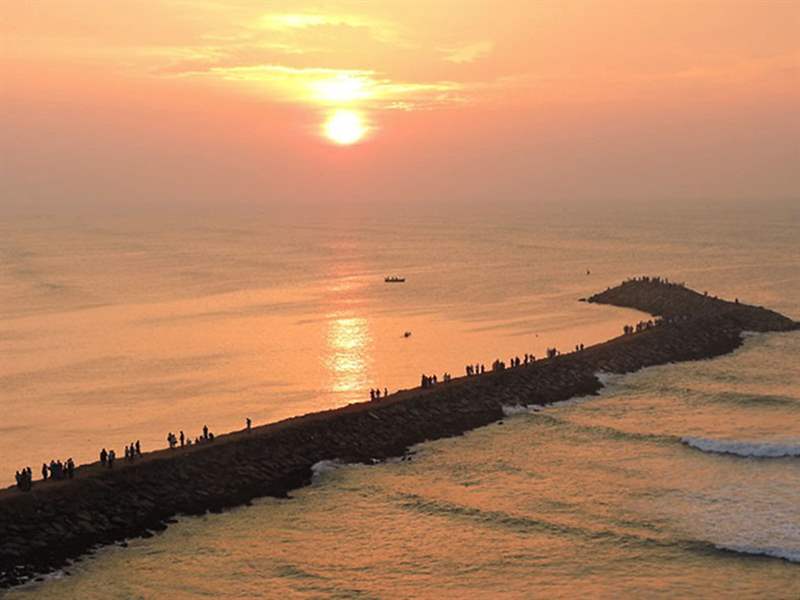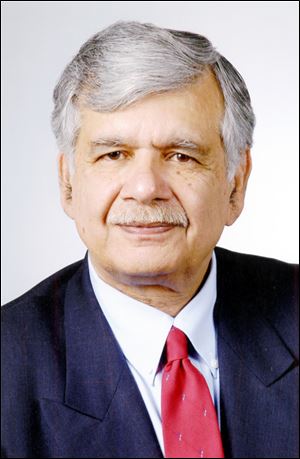
POSTCARD FROM INDIA
Pilgrims converge on coast to wash away their sins
5/18/2014
People line up at dawn on the shore and on the dike at Kanyakumari to welcome a new day.
S. AMJAD HUSSAIN

Dr. Hussain
KANYAKUMARI, India — The chants and devotional Hindu songs started early at the crack of dawn. Soon the church bells melded in the chorus. Added to the mix was the faint call of a muezzen from a distant mosque urging the faithful to the first prayers of the day. They were all heralding the start of a new day and in a way to nudging the sun to rise from its night-rest in the ocean.
Tourists and devotees were making a beeline on the dike that extended like a huge bent finger into the ocean. In the twilight of the dissipating darkness, the dike looked like a serpent resting on ocean’s surface. Slowly the golden disc emerged from the ocean and ever so gradually rose over the horizon. A new day had begun.
At the most southern point on the map of India, Kanyakumari is the place from where India starts. With my back to the ocean, I could feel the weight of the enormous landmass called India that extends from the edge of these waters for over 2,000 miles north to the snow-clad Himalayas.
It is the place where pilgrims have come for millennia to wash away their sins at the confluence of the Bay of Bengal, the Indian Ocean, and the Arabian Sea.
The town is named after Devi Kanya, a goddess in the pantheon of Hindu gods and goddesses. Deeply rooted in mythology, the legend celebrates the triumph of Devi Kanya — a virgin reincarnation of Lord Shiva’s consort Parvati — over Banasura, the king of demons. The temple dedicated to her is visited by devotees including ascetics and sanyasis who, in pursuit of spiritual fulfillment, renounce worldly pleasures.
The impressive temple overlooks the ocean. The male pilgrims are required to take off their shirts and shoes before entering. Women are required to be barefooted only. At the inner sanctum a statue of the young goddess, carved in blue stone, stands serenely and majestically with a rosary in her right hand and a sparkling jewel in her nose.

People line up at dawn on the shore and on the dike at Kanyakumari to welcome a new day.
The devotees pass in front of the statue, place the offering of money in a brass plate held by a priest, and receive a dab of sacred paint on their foreheads. With the presence of so many people packed in a rather confining place and with the outside temperature hovering around 104 degrees, it was hot, humid. But the pilgrims were content to be there as they slowly and patiently inched forward to be in the presence of the goddess. A priest held a brass plate where the devotees place the offering of money and received a dab of dark paint on their foreheads. It could be a peaceful place of quiet meditation but for so many pilgrims inside, that was not possible.
Also on the oceanfront is the Gandhi Mandapam, a memorial dedicated to Mahatma Gandhi. Considering his religious inclusiveness, the three-story structure incorporates Hindu, Christian, and Islamic architecture. Part of Mr. Gandhi’s ashes were scattered at the confluence of oceans in front of the memorial.
People come to Kanyakumari from all over India and from abroad. Some are tourists and holidaymakers, others pilgrims and seekers.
Amritha Mukesh, a young businesswoman and a foody, had come to Kanyakumari because of a vision in which Devi Kanya had asked her to come. She put her work on hold and made the journey of a thousand miles to respond to that call. It was not a rare occurrence for her; she had in the past been summoned, as she put it, to various shrines and temples in India. A cheerful modern Indian woman, she was deeply rooted in her religion and took her visions very seriously.
Others come because of simple devotion and a desire to cleanse themselves of their sins and ills. Still others come as curious tourists to enjoy the diverse architecture, the ocean, and the temperate climate.

The shops in the bazaars around the temple and other memorials are choke-full of religious mementos, souvenirs, and temple offerings. Hucksters and peddlers abound. They would sell you “real pearls” for pennies or push “genuine” Ray Ban glasses or wristwatches for the price of a soft drink. At times, it was expedient to just buy the stuff and walk away instead of having the tenacious peddler get constantly in your face. On the streets of Kanyakumari, as elsewhere in India, the word no is not understood well.
At the Gandhi Memorial, I handed my shoes to a smooth-talking custodian. He pushed a “real pearl” for 50 rupees (95 cents), lamented the financial plight of his assistant, and offered to read my palm for 100 rupees to tell me about my bright future which included a visit to America. The cynic in me wanted to ask if he knew about his own future.
Just a proverbial stone’s throw from the shore stand two monuments on two twin rocks. One is the massive —133 feet tall — statue of Saint Thirualluvar, an ancient Tamil poet-philosopher from early centuries of the Common Era. The other is dedicated to a relatively modern sage Swamy Vivekanada.
It was in 1893 that during his spiritual wanderings in the Indian subcontinent, Swami came to Kanyakumari and meditated for three months on what he called the “last bit of Indian rock.” Soon thereafter, he sailed to the United States to participate in the historic Parliament of the World Religions. He is credited with introducing Hindu philosophy to the West and as well as to India. He is revered across the country, and his statues can be found in almost every major city in India.
The town of Kanyakumari is a delightful combination of the old and the new. At some hotels the guests have to enter their names and particulars in old-fashioned, over-sized registers that are placed next to the computers sitting on the registration desk. During the stay, guests are required to sign slips of paper called cash memos for laundry, meals, and various other services.
A sign in my room at Sea Shore Hotel informs the guests, in charming subcontinental English, “The missing or damage of any items from the room will be liable on your good self.”
So this good self remained very careful during his stay.
Dr. S. Amjad Hussain is a retired Toledo surgeon.
Contact him at: aghaji@bex.net